Oooo, I am very excited about having received these beautiful wood blanks in the post yesterday! They were neatly separate into individual bags according to the tree species and are extraordinary, intricate, detailed and very special indeed. I can't wait to put them together with the first batch of puzzle boards as little wood knobs.
We are going on holiday next week but I know I will be itching to get back so that I can finally put together the first real puzzle boards for sale!
11/29/2011
11/24/2011
yule tid
Greetings.
It is has been a couple of months since I popped in here. Wow, time flies. Busy busy times at the moment with christmas coming up. For the crafty and creative person comes a-whole-lot-of-stuff-to-do panic around about this time of the year. I took a chill pill the other day and made some decorations for our hallway. I have saved all these fruit netting bags to find a reuse for them and they finally came handy to create this hanging, pagan queen like woman...I love the simplicity of this piece and the best part of this is that I get to eat more ice cream now to get more sticks! This pagan theme is reminding me that I am finally coming to terms with the complexity of my scandinavian heritage and my newfound home in australia...I am working towards embracing both in finding a pathway for my creative streak.
 |
| Hanging decoration in hallway |
 |
| Pagan queen |
I also had some scraps lying around after finishing a bouquet arrangement for my friends wedding flowers. I used this awesome (but expensive) hat making mesh and it is quite stiff which makes for great folded flower like shapes with bits of fabric stuck in it.
 |
| Fabric flower |
It is the first advent on sunday (not that i am very religious but it is a nice custom regardless). Got some christmas decorations up, next on the itinerary are the stockings. Have all the materials, just need to finish the tie I am sowing for my partner for a wedding we are going to next weekend. Pweh, hard life being a maker. (NOT)
oh, ps. YES. We finally moved the TV away from our main living area, the conversations that has enabled over the last week is unreal. Loving it.
9/15/2011
Bottom-up urbanism at its finest - Heath Nash at HIFA 2011
 |
| Recycle plastic bottle pattern - Image via designboom courtesy of Heath Nash |
This project includes all the things that I love about design and more specifically about the urban landscape and meaningful spatial site interventions. Heath Nash, project coordinator and designer produced and organised this work along with local artisans for Harare International Festival of the Art. HIFA performing arts festival 2011. The South-African designer, reused thousands of recycled plastic bottles and other materials such as plastic buckets and aluminium cans to create a set of canopies for the urban dweller to take to when in need of shade. According to designboom, Nash got the inspiration from simply walking the streets of the Zimbabwean capital whilst observing how people occupied and congregated under the city's tree canopies so to avoid the Southern African mercury.
This observation was translated into a pragmatic and spatial take on the idea of recycling waste materials derived from consumption.
 |
| Components of an extensive distribution system - Image via designboom courtesy of Heath Nash |
The way in which the canopies are constructed is simply magic. Repetitive pattern is one of the most powerful ways of generating beauty and striking form in my eyes and the combining of cultural and social observation with a commentary of mass-consumption, leads way to a meaningful site intervention.
The project suggests a site intervention that is constructed at a 1:1 scale, utilising local craftsmanship with the organising mind of a designer. The other beauty in this project lie in the system that this 1:1 site intervention actually represents. Where all these bottles, cans and buckets come from remain unrepresented, perhaps it is not doable but I hope that you get the picture. A 1:1 intervention that assembles tens of thousands of small objects that was part of a mass-distribution system going out for consumption to then be returned to another system, that of recycling and end up in this meaningful installation. Simply beauty.
 |
| re-ordering, re-assembling, re-configuring - Image via designboom courtesy of Heath Nash |
 |
| process - Image via designboom courtesy of Heath Nash |
Labels:
design process,
event,
festival,
installations,
landscape architecture,
making,
materials,
remaking,
scale,
urbanism,
Zimbabwe
7/27/2011
Light my pulp
A lovely design process by Enrique Romero de la Llana. The designer created these lamp shades using old newspapers, mixing them into a paste and drying them out into various simple and organic forms. I have totally developed a fetish for lamp shades these days!
Over at Design Milk, they observed the upcycling of the newspaper into a somewhat celebration of the tree that once was the paper. I find this to be the case because of the texture that the designer achieved for the lamps. It reminds me of old gnarly and fairy like trees.
Images below from design milk
Over at Design Milk, they observed the upcycling of the newspaper into a somewhat celebration of the tree that once was the paper. I find this to be the case because of the texture that the designer achieved for the lamps. It reminds me of old gnarly and fairy like trees.
Images below from design milk
Labels:
design process,
interiors,
lighting,
materials,
modelling,
non-linear history,
remaking,
Spain
7/10/2011
Ebony Bizys - Everyday Tokyo
These photos by graphic designer Ebony Bizys are just the type of everyday landscape that I am researching for my own design projects.
I love how this landscape of pots and interior furniture and fittings represents ordinary everyday life of the city's inhabitants and their desire to make a mark on their surroundings. Claiming a little bit of space, growing, nursing and caring for a little bit of life, a small scale intervention in a 21st century large scale city. You might want to check out: urban interior, a group of researchers based in Melbourne that recently released a book exploring the idea of urban interior.
I love how this landscape of pots and interior furniture and fittings represents ordinary everyday life of the city's inhabitants and their desire to make a mark on their surroundings. Claiming a little bit of space, growing, nursing and caring for a little bit of life, a small scale intervention in a 21st century large scale city. You might want to check out: urban interior, a group of researchers based in Melbourne that recently released a book exploring the idea of urban interior.
 |
| image via otherpeopleshouses |
 |
| image via otherpeopleshouses |
 |
| image via hellosandwich |
 |
| image via hellosandwich |
Labels:
design process,
informal,
installations,
interiors,
Japan,
landscape architecture,
scale,
Tokyo,
urbanism
7/08/2011
Roskilde wee tree pee
 |
| p-tree by Aandeboom, via dezeen |
I LOVE the Roskilde festival, I used to religiously go every summer back in my teens and I LOVE this clever urinal solution by dutch designers Aandeboom. I guess the only criticism I have with this intervention is: how will the ladies go with it? I guess in the state that I put myself in on these festivals, personal space is sort vanished anyway, bloody heck, I used to shower butt naked with thousands of people and nobody frowns upon it, so perhaps this critique doesn't belong here?
The urinal can be connected to the main sewer system or a tank via pump. I guess if it was a lemon tree that wouldn't be necessary because apparently the thrive in a p-environment. (do not take this too seriously tho)
Although, it would be nice to see a picture of a female using this.
 |
| p-tree by Aandeboom, via dezeen |
 |
| p-tree by Aandeboom, via dezeen |
Labels:
Denmark,
festival,
installations,
Netherlands
7/06/2011
Drawing on old chests
 |
| drawers remade into kitchen units, via dornob |
 |
| drawers remade into chest, via dornob |
These reinvented chest of drawers are amazing. Not only is the process of salvaging individual drawers from a life in despair at the local landfill commendable, but the combining of separate drawers with completely different histories and origins into a new frame of life is truly inspirational. That is the romantic DRAWING card for me here; igniting new life into the old and creating a unique aesthetic and functionality to each piece. I absolutely love the aesthetic of this work.
Although Hamburg based design company entwurf-direkt creates single drawer-shelves as well for attachment on walls and also for stacking; I have to point out for my own records that although old is brought into new life, it is still serving the same function as it once had and has not completely been remade and rethought into a new function. It is a combination of the two. Hence, an alternative take on the idea of remaking. 1/2 remake.
I also like how the designers stamp and number their works. This creates another meaning to the pieces as they make their way out into the big world of people's homes and become part of a larger system.
 |
| assorted pieces. via dornob |
It's interesting that some photos are taken outside of the chest of drawers. Interesting choice of environment. I wonder how this concept could be translated into an intervention in the landscape. Reinventing drawers from the landscape. How can I conceptualise the idea of drawers into the landscape?
Bird Hotel not in trees
 |
| bird cafe by Teddy Luong and Dennis Cheng for Umbra |
via designmilk
This is a nice little design but I can't help pondering the designing of the birds actual habitat in the form of trees. The spatial qualities would improve with the planting of trees and shrubs instead or in addition to.
Unless, of course, you designed this little bird house for an urban installation. It has a quicker impact on the site than waiting for a tree to grow. So here it is: install this little bird house design whilst you wait for their actual tree/shrub habitat to grow in the meantime. Greatness!
Labels:
birds,
informal,
installations,
making,
scale
6/28/2011
Sick Cocoon and Sick Ball by Jeannine van Erk
 |
| photo via designboom, image courtesy of bel+bo |
Jeannine van Erk works for Berlin based design studio bel+bo and exhibited these works at the DMY Berlin (Berlin International Design Festival) held this earlier this month.
This is how the designers describe these products:
Cocon- Malade and Boule Malade are unique, handcrafted lampshades.
Their individuality is achieved by hand-made, specially dyed natural materials.
Because of the craftsmanship of the Dutch designer, Jeannine van Erk, each lampshade is different.
Their special quality is warm, atmospheric light in a simple, yet contemporary design.
The color chosen for an order is never exactly the same as shown. These are natural pigments,
so they will vary slightly.
 |
| detail view of sick cocoon bandage lantern via designboom |
 |
| cocon and boule malade, assorted colours, image via designboom, image courtesy of bel+bo |
 |
| designer making the sick lanterns, image via designboom, courtesy of bel+bo |
6/20/2011
State of Design 2011 Festival Guide - Now available
This years State of Design festival guide has been launched and is available from their website, here.
The theme for this year's festival is Design that moves. Personally, I am interested in the interventions that take place outside in the urban fabric, such as the Landscape Urbanism 72 Hour Urban Action in the Docklands that sees teams of architects, builders, landscape architects, urban designers etc...live, eat, sleep and work on their chosen sites and construct new urban forms through site specific interventions. (Correction, the name of this event has now changed to Urban Realities, Landscape Urbanism 3 Day Design Challenge.
 |
| Chasing Kitsune, from here |
Hassell's Chasing Kitsune which is a Japanese food truck that will make its way around the city and adapt to its imnmediate surroundings, Mapping the Burbs, which is an Architectural discovery tour conducted on your bike.
Camp Street CampOut + LookOut, which invites you to design and recreate the tent city for a day. Participants are invited to pitch their designs for a tent and display it in Alfred Deakin Place, Ballarat. Using recycled fabric, everyone is invited to tailor their tent claim a little bit of this public space.
Other than what's happening outside on our streets and beyond and true to my personal interests, there is also a worshop called MakeUp which takes you through the art of reusing and upcycling material. From transforming unwanted vintage wallpaper to reusing old yacht sailcloths and turning them into teepees.
This and much much more stuff to do in Victoria from the 20-31 July 2011.
Labels:
Australia,
event,
installations,
making,
urbanism
6/16/2011
Opening of the Highline' Section 02'
This project makes me so incredibly happy. It makes use of a disused elevated old railway system in NYC and turns it into a fantastic civic space through which one gets an alternative view of the streets of new york.
Instead of demolishing this disused infrastructure, landscape architects and urban designers Field Operations along with architects Diller Scofidio + Renfro and planting designer Piet Oudolf collaborated together to celebrate civic life in one of the worlds most famous metropolises with this elevated park corridor. Remaking an old and once vital part of the industrial city into a new, vital part of the public city.
The design celebrates the human scale, interaction between people, interaction between people and the surrounding built environment, interaction between people and industrial heritage and the interaction between people and a more romantic planting scheme that could be argued somewhat removes the visitors from the very city that this piece of infrastructure once served. As the people at dezeen describe it:
The park accommodates the wild, the cultivated, the intimate, and the social. Access points are durational experiences designed to prolong the transition from the frenetic pace of city streets to the slow otherworldly landscape above.
Instead of demolishing this disused infrastructure, landscape architects and urban designers Field Operations along with architects Diller Scofidio + Renfro and planting designer Piet Oudolf collaborated together to celebrate civic life in one of the worlds most famous metropolises with this elevated park corridor. Remaking an old and once vital part of the industrial city into a new, vital part of the public city.
 |
| perspective view, merging vegetation and the built environment around it, giving an indication of what sort of space you can expect upon visiting the Highline. |
The design celebrates the human scale, interaction between people, interaction between people and the surrounding built environment, interaction between people and industrial heritage and the interaction between people and a more romantic planting scheme that could be argued somewhat removes the visitors from the very city that this piece of infrastructure once served. As the people at dezeen describe it:
The park accommodates the wild, the cultivated, the intimate, and the social. Access points are durational experiences designed to prolong the transition from the frenetic pace of city streets to the slow otherworldly landscape above.
 |
| Top view of the Highline Park, some vegetation found on the elevated level is in fact tree canopies planted on ground level. image via dezeen |
Labels:
design process,
infrastructure,
landscape architecture,
materials,
New York,
remaking,
USA
Rudanko+Kankkunen - Vocational school in Sra Pou, Cambodia.
This is such a meaningful project by finish architects Rudanko+Kankkunen. The school was constructed with hand-dried blocks of local soil and built by the local community. via dezeen
Using materials found closeby and having the locals building the school as a design process makes this project close to the heart and it gives it more soul.
I love the colours of the window shutters, they are vibrant and contrasting to the terracotta coloured bricks.
It would've been nice to have added the surrounding lot to the design aswell. For this sort of project I would imagine having a workshop with the children and planting perhaps fruit trees and other edible crops to the school yard.
 |
| Window/Door Shutters, image by architects |
Using materials found closeby and having the locals building the school as a design process makes this project close to the heart and it gives it more soul.
I love the colours of the window shutters, they are vibrant and contrasting to the terracotta coloured bricks.
 |
| Facade, image via architects |
 |
| Student looking through the woven window shutters, image via architects |
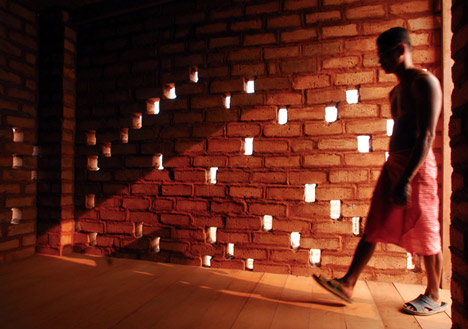 |
| Holes in wall to let sunlight through and also aid in ventilation of the building, image via dezeen |
Labels:
architecture,
Cambodia,
design process,
materials,
scale
Urban Interventions
My urban intervention Crate[or] is now online for your perusal here. Feel free to email or comment on the project. It forms a part of ongoing design research that I am conducting into approaching the city at a human scale when discussing urban development and the understanding of the forces that play out in the city.
 |
| Crate[or], photo by author |
Labels:
Australia,
design process,
informal,
installations,
landscape architecture,
making,
modelling,
remaking,
scale,
urbanism
6/02/2011
IKEA's 'Homemade is Best' - The architecture of Baking
Ikea's 'Homemade is Best' cook book contains 30 traditional Swedish baked goods recipes with a twist. Each recipe is complimented by an image of the ingredients before they are mixed together and baked. It is a wonderful documentation of the process of baking. NO, actually, it is the process of arranging the ingredients of baking.
 |
| Napoleonbakelser, before |
 |
| Napoleonbakelser,after |
The ingredients are placed in a decorative composition adjacent to each other and this image is then paired with the end result. But if I was to imagine the scenery of when I bake and cook in my kitchen, the image is a far cry from the stylized and glorified images of this book. It would be interesting to contrast this work by documenting the 'real' process of making and juxtaposition the images next to each other to further the notion of documenting a design process. Because, it is only the ingredients and the end result that is on display here, and the actual MAKING part seem to have been left out.
 |
| Kanelbullar (Cinnamon Buns) before |
 |
| Kanelbullar (Cinnamon Buns) after |
Still, a cool idea from the ad-agency Forsman & Bodenfors.
The homemade is best book serve the purpose of drawing more people towards the kitchen and obviously to IKEA's showroom. That is beside the point. These days, people seem to be more obsessed with the end result and product that they forget the beauty in the making of things. This is why I love this project. It starts to talk about the intimate and domestic in a beautiful way. It is a world away from fast-food outlets and mass-production of food.
 |
| Mandelmusslor (Almond mussels), before |
 |
| Mandelmusslor (Almond mussels), after |
Yet the irony is that this work is meant to draw people towards the mass-production of the IKEA kitchen. As if IKEA is saying: OK, so here we have it, we'll let you go back to domesticity and the art of making unique food in your own home so that you don't have to worry about getting your consciousness dirty with the immorality of mass-produced food. Leave the mass-production to us and you'll be a happy peach.
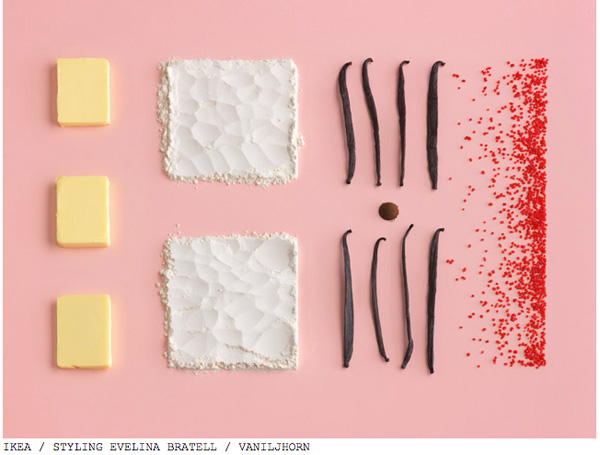 |
| vaniljhorn (vanilla horn) before, from here |
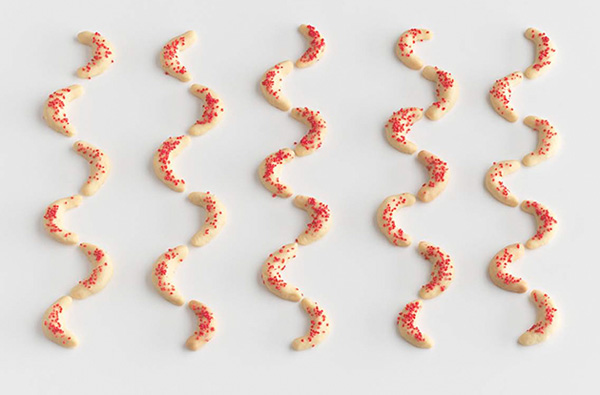 |
| vaniljhorn (vanilla horn) after, from here |
Looking at the homemade is best work, makes me a happy peach but I just want to reconfigure the work to include the process of making it as well.
Now I know the point was not that at all, it is just the way I think. Originally, the ad company made the cookbook, created an iphone app that traced your exercise and told you when you'd done enough exercise and earned the calories to eat one of the recepies. Clever, isn't it. Apparently, the ad reached 40 million people without IKEA spending a cent on media and promotional costs..somehow...I am contributing to the publicity too. Hmmm.
Here's a link to the movie.
I think I might just visually suggest how this process would look if applied to the components of an architectural project. Watch this space.
Labels:
design process,
graphic design,
making
5/22/2011
String Spectacular
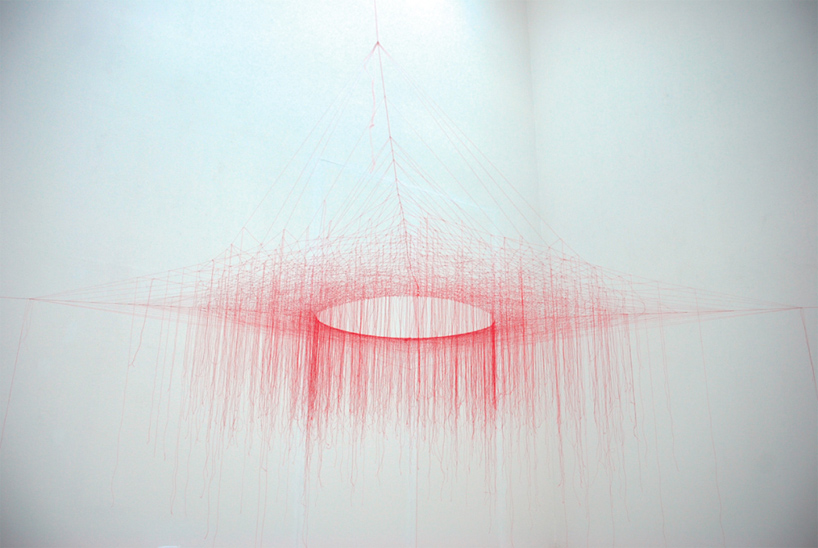 |
| full view, from designboom |
Akiko Ikeuchi knots silk thread in a process that takes up to a month for gallery installations. The works are room size scales and the work is so delicate and subtle which I think reflects the process of making it and the personality of the artist. The knots seem to reflect the daily disruptancies that one face, one by one, Ikeuchi documents these experiences into a a narrative of collective moments. One knot is one moment in time, brought together into a story. Stunning.
 |
| detail of installation showing the knots, via here |
This is a google translation of the artist's own description of the work, from Japanese to English. I believe the translation is not completely accurate but I reckon you still get the just of the intent, in fact, it is very beautiful.
ー four axonemal Azuma Minami northwest respectively, are stretched to the northeast ー southwest.
Yarn and yarn cross connectedness are all tied together with 引合Tsu.
Yarn and yarn cross connectedness are all tied together with 引合Tsu.
Red is the color of my approach to life and responded to the incident which occurred in the past two years.
Is evidence of every single knot in my day.
Is evidence of every single knot in my day.
It has spanned many times is still tied at first glance, that appears to be strong and stable,
Breaks down quickly once the off-axis yarns.
Breaks down quickly once the off-axis yarns.
The world is made up of subtle fragile balance.
□
"A feeling" came over the fade again.
Kind of vibration?
Words can not.
And narrowed his eyes, threw out - and as you seem to try to slightly roll the brain.
If they disappear quickly enter forcibly separated.
Kind of vibration?
Words can not.
And narrowed his eyes, threw out - and as you seem to try to slightly roll the brain.
If they disappear quickly enter forcibly separated.
The silk tie by keeping it connected and the sensor.
Some exposure to light and air, see how hiding something that faintly.
That you kept going away before it's light and air inside the right or not.
Because I have that desire to with it.
That you kept going away before it's light and air inside the right or not.
Because I have that desire to with it.
I believe this particular piece was exhibited at gallery 21 in 2009.
 |
| Edith Derdyk, Slice, 2003 4.000 meters of black cotton line, 2.800 stapples and 4 days of setting up Arco Feira de Arte, Madrid, Spain photo: Edith Derdyk |
To continue on artists that work with string and thread, Brazilian artist Edith Derdyk's work is also absolutely stunning.
 |
| Edith Derdyk, Rasures III, 1998 60.000 meters of black cotton line, 10.000 stapples and 13 days of setting up City Canibal, curator: Daniela Bousso Paço das Artes, São Paulo, Brazil photo: Gal Oppido |
It is the visual intensity and the rigorous process of creating the piece that impress and interest me the most. Derdyk's process begins with drawing and the idea of the line, according to the artist.
 |
| Edith Derdyk, Projects and sketches, 1999/2001 Ball-point pen, paper |
 |
| Interlineation, 1998 Drawings Paper, black cotton line, vinyl glue 50 x 180 cm photo: Rômulo Fialdini |
This is quite a full on description of her work by Arnaldo Artunes in his mini essay Cocoon, found here:
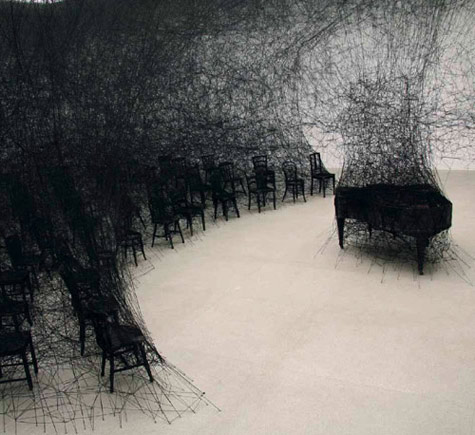 |
| Chiharu Shiota, In silence, 2009 centrepasquart, biel bienne, switzerland |
I have also had a huge crush and massive respect and awe for installation and performance artist Chiharu Shiota, who's work is short of absolutely gobsmackingly spine chillingly god damn spectacular and who recently exhibited at the 'detached' gallery in Hobart that I sadly missed. Above is a 2009 piece from In silence, a progressive art/installation piece that has been erected and showed at a number of different locations since 2007 when it was part of a performance at the Kanagawa Arts Foundation, in Kanagawa, Japan. (below). Of course, the process of making this space, the setting up and weaving of the wool is of particular interest for me but also the intent of Shiota, who wants to depict the sound of silence in space.Very beautiful.
 |
| In Silence, Toshi Ichiyanagi x Unit2007, found here |
 | ||
| Chiharu Shiota, "In Silence" (2008). Piano, Chairs, Wool |
Labels:
art,
design process,
installations,
network
Subscribe to:
Posts (Atom)






